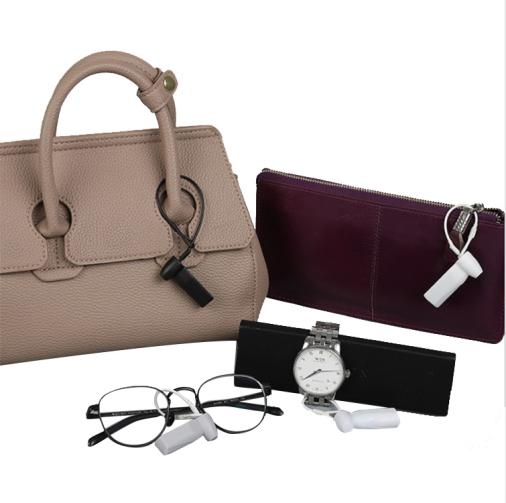1. The cashier is easy to find, convenient for degaussing/removing nails
2. No damage to the product
3. Does not affect the appearance
4. Do not cover up important information on goods or packaging
5. Do not bend the label (the angle should be greater than 120°)
The company recommends that the anti-theft labels be placed in a unified location. Some products have an anti-theft label built into the product when they are processed in the factory. It should also be in a unified location to facilitate the cashier to find the location in an emergency.
Hard Tag installation
First determine the position of the label on the product, pass the matching nail out from the inside of the product, align the hole of the label with the nail, press the label nail with your thumb until all the nails are inserted into the label hole, and you will Hear a “cuckling” sound.
Hard tags are mainly suitable for scope and placement method
Hard tags are mainly applied to textiles such as clothes and pants, as well as leather bags, shoes and hats, etc.
a. For textile products, as far as possible, the matching nails and holes should be inserted through the stitches of the clothing or button holes, trousers, so that the label is not only eye-catching and does not affect customers’ fittings.
b. For leather goods, the nails should pass through the button hole as much as possible to avoid damage to the leather. For leather goods without button holes, a special rope buckle can be used to put on the ring of the leather goods, and then nail a hard label.
c. For footwear products, the tag can be nailed through the button hole. If there is no button hole, you can choose a special hard label.
d. For some specific commodities, such as leather shoes, bottled alcohol, glasses, etc., you can use special labels or use rope buckles to add Hard tags for protection. Regarding the special label, you can ask us about it.
e. The placement of hard tags on the goods should be consistent, so that the goods are neat and beautiful on the shelf, and it is also convenient for the cashier to take the sign.
Note: The hard label should be placed where the label nail will not damage the product and is convenient for the cashier to find and remove the nail.
External adhesion of soft labels
a. It should be affixed to the outside of the product or product packaging, on a smooth and clean surface, while keeping the label straight, pay attention to its appearance, and do not stick the soft label on the product or packaging where important instructions are printed, such as product composition, use Method, warning name, size and barcode, production date, etc.;
b. For products with curved surfaces, such as bottled cosmetics, wines, and detergents, soft labels can be directly pasted on the curved surface, but attention should be paid to flatness and not too large curvature of the label;
c. In order to prevent illegal tearing off of the label, the label adopts a strong sticky self-adhesive. Be careful not to stick it on leather goods, because if the label is forcibly removed, the surface of the goods may be damaged;
d. For products with tin foil or metal, soft labels cannot be directly pasted on them, and a reasonable sticking position can be found with the hand-held detector;
Concealed adhesion of soft labels
In order to better play the anti-theft effect, the store can place the label in the product or product packaging box according to the characteristics of the product, mainly for the product to be adhered to the unified position in the packaging box when the product is processed in the factory.
Soft label sticking rate
More soft labels should be affixed to goods with more serious losses, and sometimes even re-sticking; for goods with lower losses, soft labels should be affixed less or not. Generally speaking, the rate of soft labeling of goods should be within 30% of the products on the shelves, but the store can dynamically grasp the rate of labeling according to the management situation.
Post time: Sep-07-2021


